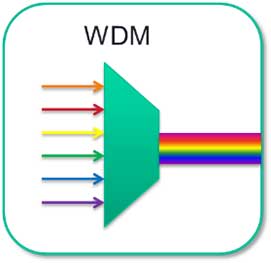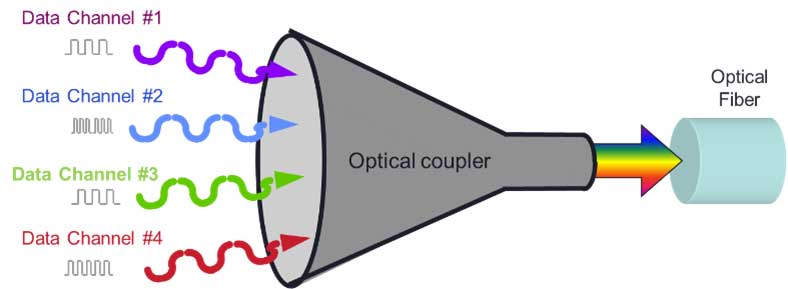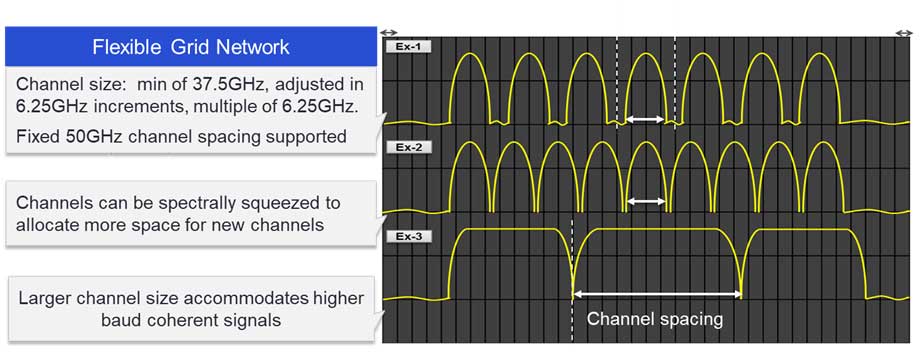What is WDM or DWDM?
 Early fiber-optic transmission systems put information onto strands of glass through simple pulses of light. A light was flashed on and off to represent digital ones and zeros. The actual light could be of almost any wavelength—from roughly 670 nanometers to 1550 nanometers. Wavelength Division Multiplexing, or WDM, is a technique in fiber-optic transmission that uses multiple light wavelengths to send data over the same medium.
Early fiber-optic transmission systems put information onto strands of glass through simple pulses of light. A light was flashed on and off to represent digital ones and zeros. The actual light could be of almost any wavelength—from roughly 670 nanometers to 1550 nanometers. Wavelength Division Multiplexing, or WDM, is a technique in fiber-optic transmission that uses multiple light wavelengths to send data over the same medium.
During the 1980s, fiber-optic data communications modems used low-cost LEDs to put near-infrared pulses onto low-cost fiber. As the need for information increased, so did the need for bandwidth. Early SONET systems used 1310 nanometer lasers to deliver 155 Mb/s data streams over very long distances.
But this capacity was quickly exhausted. Over time, advances in optoelectronic components allowed the design of systems that simultaneously transmitted multiple wavelengths of light over a single fiber, significantly increasing fiber capacity. Thus, WDM was born. Multiple high-bit-rate data streams of 10 Gb/s, 40 Gb/s, 100 Gb/s, 200 Gb/s and more recently, 400 Gb/s and 800 Gb/s, each carrying distinct throughputs, can be multiplexed over a single fiber.

There are two types of WDM today:
- Coarse WDM (CWDM): CWDM is defined by WDM systems with fewer than eight active wavelengths per fiber. CWDM is used for short-range communications, so it employs wide-range frequencies with wavelengths that are spread far apart. Standardized channel spacing permits room for wavelength drift as lasers heat up and cool down during operation. CWDM is a compact and cost-effective option when spectral efficiency is not an important requirement.
- Dense WDM (DWDM): DWDM is defined in terms of frequencies. DWDM’s tighter wavelength spacing fits more channels onto a single fiber, but costs more to implement and operate. DWDM is for systems with more than eight active wavelengths per fiber. DWDM dices spectrum finely, fitting 40-plus channels into the C-band frequency range.
With DWDM, vendors have found various techniques for cramming 40, 88, or 96 wavelengths of fixed spacing into the C-band spectrum of a fiber. Traditional DWDM line systems use Wavelength Selective Switches (WSS) designed with fixed 50GHz or 100GHz filters. These fixed-grid line systems can accommodate channels from early generations of coherent transponders whose wavelengths require less than 50GHz or 100GHz of spectrum (depending on the filter used). Today, networks with high- bandwidth applications and sustained bandwidth growth that are quickly facing capacity exhaustion are turning to C+L-band solutions, which also leverage the L-band spectrum of a fiber to potentially double the fiber capacity.

As optical networks evolve to meet today’s ever-increasing bandwidth demands, so has the dependence on next-generation programmable coherent technology to maximize fiber capacity and lower the cost per bit of transport. To fully take advantage of these benefits requires a flexible-grid line system that can accommodate these higher-baud channels, such as an 800G wavelength, that require more than 100GHz of spectrum.
WDM is a technique in fiber optic transmission for using multiple light wavelengths to send data over the same medium.
In fact, today’s next-generation coherent modems are so intelligent and programmable that the modem considers a greater variety of constellation and baud options, enabling extremely granular tunability. Today, flexible channel plans are possible, enabling anything from 64 x 75GHz channels or 40-45 channels for higher, 800G line rates—leveraging a flexible grid (or gridless) architecture that supports channels with a minimum size of 37.5GHz, with adjustable increments of 6.25GHz—to accommodate any channel available today or in the future.

When boosted by Erbium Doped-Fiber Amplifiers (EDFAs) and Raman amplification—two performance-enhancing technologies for high-speed communications—the reach of these DWDM systems can be extended to work over thousands of kilometers. For robust operation of a system with densely packed channels, high-precision filters are required to peel away a specific wavelength without interfering with neighboring wavelengths. DWDM systems must also use precision lasers that operate at a constant temperature to keep channels on target.
One of the best features of deploying DWDM over a flexible grid photonic line system is signal independence—the ability to support multiple generations of transponders independent of format, bit rate, symbol rate, etc. As such, many networks designed for 10 and 40 Gb/s are now carrying 200 Gb/s channels, and many that were deployed with flexible grid capability are now carrying 400 Gb/s and even 800 Gb/s signals!
Ciena offers the full breadth DWDM solutions to address customer requirements, from the edge to the core, over a flexible range of platforms. Ciena’s 6500 Family, Waveserver Family, and Routing and Switching portfolio of 51xx and 81xx platforms leverage programmable WaveLogic coherent technology across integrated hardware modules, as well as pluggable coherent optics.
As an example, Ciena’s popular 6500 Packet-Optical Platform leverages the latest technology innovation to deliver new levels of scale, flexibility, and programmability across three comprehensive networking layers for customizable service delivery over any distance. Built for efficient network scaling from the access to the backbone core, the 6500 provides technology-leading programmable infrastructure that enables the software control, automation, and intelligence required for a more adaptive network. It offers the full gamut of CWDM and DWDM solutions across a fully agile, instrumented photonic system, including support for flexible grid CDC ROADMs, with DWDM solutions ranging from 10 Gb/s to 800 Gb/s.





